Multipurpose armored vehicle M39 (USA)
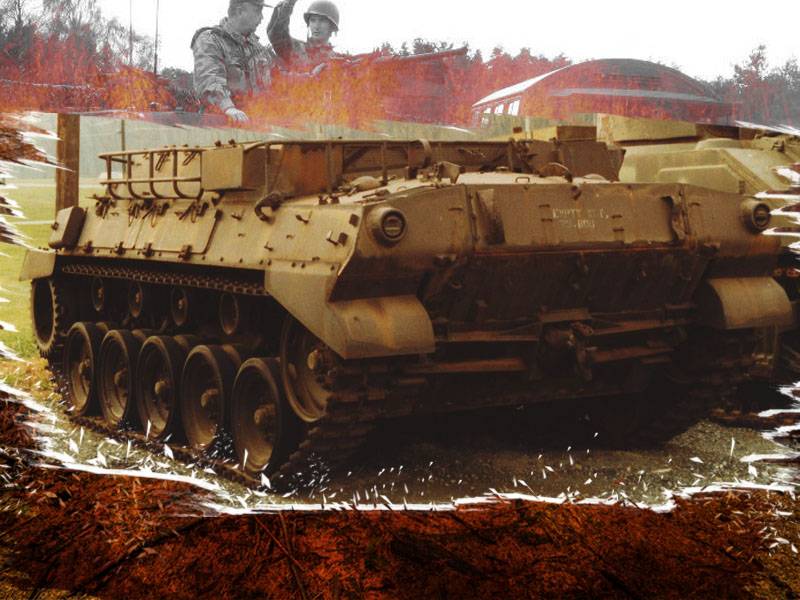
During the Second World War, the American army exploited a significant number of armored personnel carriers and artillery tractors of several models. The equipment with a semi-tracked undercarriage was widespread during this period. Continuing work in two major areas led to the emergence of an interesting sample of an auxiliary vehicle, which solved several tasks during the war and later had a significant impact on the further development of American armored vehicles. It was the “armored utility vehicle” Armored Utility Vehicle M39.
The prerequisites for the emergence of a new transport vehicle were quite interesting. In 1943, the M18 Hellcat anti-tank self-propelled artillery mount, armed with an 76-mm cannon, was put into the series. By the middle of next year, it became clear that this machine, with all its advantages, no longer fully complies with current requirements and therefore must be replaced. To replace the existing technology was created new self-propelled gun M36. In the autumn of 1944, the M18 mass production was curtailed, the operation of such equipment was supposed to continue until the new machines were completely replaced.
The M18 self-propelled gun was not powerful enough, but its chassis could still be of interest to the military and used in a new role. Already in the summer of 1944 there was a proposal for the modernization of fighters tanks with alteration in auxiliary cars. By a relatively simple rework, a serial self-propelled gun could become a multi-purpose transport armored vehicle, suitable for use on different roles. Such vehicles should have had significant advantages over existing semi-tracked vehicles. It could advantageously be distinguished by a higher level of protection provided by another armored hull, and improved mobility achieved by a fully tracked chassis.
The new draft of the general purpose machine received the working designation Armored Utility Vehicle T41. This name was maintained until the beginning of 1945, when the car was officially adopted under the designation Armored Utility Vehicle M39. For convenience, the class of technology, reflected in its name, is often reduced to AUV.
The authors of the T41 project proposed a fairly simple way of converting self-propelled artillery systems into transport equipment. With the production machine type M18 Hellcat should remove the turret with a gun and all the original equipment of the crew compartment. In addition, the roof was removed from the hull. On the vacant places it was proposed to mount a variety of equipment necessary for the transport of goods or passengers. All other components and assemblies of the existing chassis remained unchanged.
In accordance with the basic ideas of the project, the base ACS had a relatively thin reservation, which, however, made it possible to obtain high mobility and ensure sufficient survivability on the battlefield. After dismantling the tower and installing new equipment, a promising multi-purpose machine had to maintain similar qualities and even increase mobility by reducing weight.
The new transport vehicle has retained the main body of the base sample. The M18 self-propelled gun received armor up to 12,7 mm thick. The front part of the body had a wedge-shaped profile and a large opening for servicing the transmission, covered with a removable cover. Behind the upper inclined sheet was a small horizontal section of the roof of the hull with the crew hatches. There were no changes to the low niches, formed by several inclined sheets. The shape of the stern also did not change: it still consisted of several sheets, installed vertically or with a slope.
Removing the tower made it possible to recycle the turret box to solve new problems. The former fighting compartment lost its roof, which facilitated access to the inside of the car. To increase the usable volume and additional protection of passengers on top of the original body, a low armored cabin was added. It consisted of four trapezoid sheets assembled into a truncated pyramid-shaped structure. The front sheet of such a cabin had a small cutout in the upper part - it was intended for mounting a machine-gun installation. At the sides of the cabin there were narrow details, slightly covering the inner compartment. Also on the upper side parts and aft provided for the installation of lattice baskets for the transport of various property.
The layout of the case was being finalized in accordance with the new role of the machine, but it was not subjected to cardinal processing. In front of the building, there is a small compartment to accommodate the transmission units, behind which they placed the two-seat control unit. A large central volume under the cabin could perform the functions of a cargo compartment or a troop compartment, depending on the task. In the stern was still a compartment for the engine. Thus, the changes affected only the central part of the corps, which lost its standard combat compartment.
In the aft compartment of the hull of the base SAU and, as a result, of the T41 conveyor, there was a radial nine-cylinder four-stroke gasoline engine Continental R-975-C4 with a capacity of 400 hp. With the help of a cardan shaft, the engine was connected to the transmission unit, placed in front of the case. There was a transmission type 900T Torqmatic, providing three forward speeds and one reverse. The structure of the power plant included fuel tanks with a total capacity of 625 l.
The undercarriage was borrowed from M18 unchanged. On each side there were five double support rollers with rubber bands. The rollers had an individual torsion bar suspension. All pairs of rollers, with the exception of the average, received additional shock absorbers. In front of the hull were placed the drive wheels with toothed crowns, in the stern - guides, equipped with a caterpillar tension mechanism. Due to the use of small rollers, four supporting rollers on board were included in the running gear.
For self-defense armored auxiliary machine received a machine gun installation. In the upper part of the frontal leaf of the new cabin, there was a support ring of the turret, along which the support of the machine gun could move. Using such a device, the shooter could attack targets in any direction with significant elevation angles. The turret was mounted heavy machine gun M2HB. Ammunition weapons consisted of 900 cartridges in several tapes, placed on the appropriate packing inside the case.
Own car crew consisted of three people. On the left in the control room was the driver, on the starboard side was his assistant. Access to the control room was provided by two hatches in the roof. Behind the department of management, mainly in the cargo-passenger compartment, was the commander. His duties included tracking the surrounding space, as well as the use of a machine gun. For obvious reasons, the commander did not have his own hatch.
The payload was to be located in the central compartment of the hull, previously used as a fighting compartment. At the front and rear walls of the compartment placed two sets of folding seats for the transport of soldiers. Together with three crew members on board could be up to eight paratroopers. The project AUV T41 initially envisaged the use of technology as an artillery tractor, and therefore the central compartment could be used to transport ammunition. Boxes with shells could fit directly on the floor of the troop compartment. The calculation of the towed gun was also placed inside the hull. The gun itself was proposed to be transported using a stern tow hook.
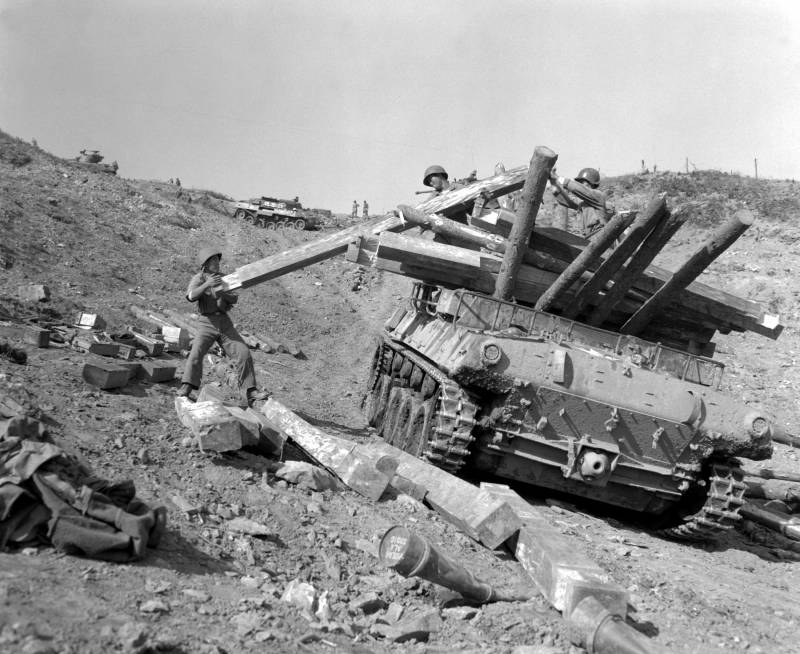
Transport M39 as a carrier of logs necessary for the construction of a dugout. Korea, October 1 1952. US Army Photo
The refusal to use the tower led to the fact that the transport machine T41, with similar body dimensions, was noticeably smaller and lighter than the base self-propelled gun. The length of the transport was 5,3 m, width - 2,4 m, height on the roof - 2 m. The combat weight was 15,17 t. A large number of artillery shots could be placed in the cargo hold. The number of projectiles transported depended on their type and the task set before the artillerymen.
The lightweight transport vehicle was distinguished by a fairly high power density — more than 26 HP. per ton. Due to this, on the highway, it could reach speeds of up to 80 km / h, fuel was enough for 160 km of track. It was possible to overcome climbs with 60% steepness, trenches 1,86 m wide or walls 91 high, see. Water barriers up to 1,2 m depth were overcome ford. Turning radius - 20 m. When towing an artillery gun, restrictions could be imposed on maximum speed, etc., aimed at preventing its damage.
By the autumn of 1944, the Buick company, which produced the M18 Hellcat ACS, received an order for the manufacture of two experimental transport vehicles of the AUV T41 type. For the construction of this technique were taken two serial self-propelled guns. Re-equipment of finished machines did not take much time, due to which prototypes of the tractor-conveyor soon entered the landfill. The use of ready-to-use and proven chassis allowed us to do without lengthy tests. Sufficiently high characteristics of the promising machine and so were obvious.
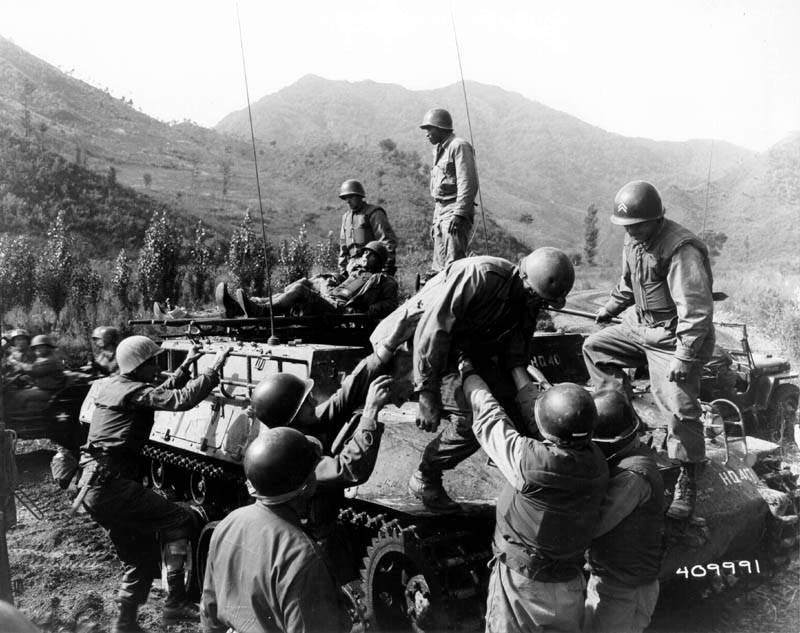
M39 as an ambulance. Korea, October 14 1952. US Army Photo
In the autumn of the same year, the Hellketov manufacturer received a contract for the mass production of the latest multi-functional machines. Available self-propelled guns had to come to the manufacturer, where they had to be repaired and re-equipped according to a new project. In October, the 44 Army transferred the first batch of 10 production vehicles. In November, the military received another 60 transporters. In December 1944 and January 1945, the 163 and 180 machines were built respectively. In February and March, the customer also received 227 machines. In March 1945, the production of the transport vehicle was discontinued. For half a year the company Buick released 640 units of new technology. Interestingly, before the start of the 45 machine, they had a working designation T41. The official name of the Armored Utility Vehicle M39 was assigned to them only at the beginning of the new year.
New armored cars quickly got to the front, where they began to be used for its intended purpose. The first “specialty” of T41 / M39 was the transportation of M6 anti-tank guns. In the role of such a gun, the conveyor could carry a calculation and 42 projectile caliber 76 mm. The use of a new car as a tractor with other types of implements was not ruled out. In addition, M39 was often used to transport personnel or cargo, performing the functions of an armored personnel carrier or a protected truck.
The use of M39 multifunctional transporters as armored reconnaissance vehicles is known. Available bulletproof booking and large-caliber machine gun combined with high mobility allowed the crew to solve not only transport tasks. At the same time, in some cases insufficiently powerful booking could seriously limit the combat potential of the equipment, just as it was with the basic ACN M18.
M39 armored vehicles were exploited until the very end of the Second World War. After the end of the fighting in Europe and the Pacific, the service of such equipment continued. While the M18 baseline ACS was outdated long ago, conveyors based on it were still of interest to the army. The tractor / vehicle / armored personnel carrier remained in service until the very beginning of the 1950s, when the US Army entered the Korean War.
The appearance of new models of armored vehicles with higher characteristics made it possible to reduce the activity of using existing M39, however, even in such conditions, these machines did not remain without work. In Korea, support vehicles were used on the sidelines as ammunition carriers, armored personnel carriers and ambulances. The work of such equipment was the delivery of soldiers or ammunition to the front line, the evacuation of soldiers and wounded to the rear, etc. Full combat use of technology at the forefront, however, was excluded. The lack of a roof exposed the crew and landing to increased risks. Newer models already had a fully enclosed case, which allowed them to work in any conditions, without putting people in danger. M39 in such a situation could only count on the role of auxiliary machines.
In 1953, the Korean War ended, however, the service of the Armored Utility Vehicle M39 machines did not stop. Despite the far from complete compliance with current requirements, the small number and partially developed resource, the remaining armored personnel carriers could still be used in the army. Only 1957 decided to reject such equipment. Part of the equipment went to the disassembly, other machines were sold or transferred to the allies. Several units of such technology subsequently hit the museums and private collections.
From 640 built AUV M39 to our time lived 11. Most of the surviving specimens are in the United States. Three cars in different states remain in Germany. One machine has a private collection in the UK. During the Korean War, one M39 model became the enemy's trophy and soon hit the USSR. This car is now stored in the Kubinka tank museum.
The project of the Armored Utility Vehicle M39 multipurpose vehicle was created as a simple and effective way to find the use of obsolete self-propelled artillery installations. By not too complicated processing of the original design, a sample of armored vehicles was created, suitable for solving a wide range of tasks. This machine was so successful that it remained in service until the second half of the fifties and with a certain efficiency solved various problems of a transport nature. If we take into account the service life, we can even say that the M39 transporter turned out to be much more successful than the M18 Hellcat basic ACS. In addition, it should be noted that the appearance of this machine had a significant impact on the further development of American armored personnel carriers.
Based on:
http://historyofwar.org/
http://afvdb.50megs.com/
http://globalsecurity.org/
http://olive-drab.com/
Hunnicutt, RP Bradley: A History of American Fighting and Support Vehicles. Navato, CA: Presidio Press, 1999.
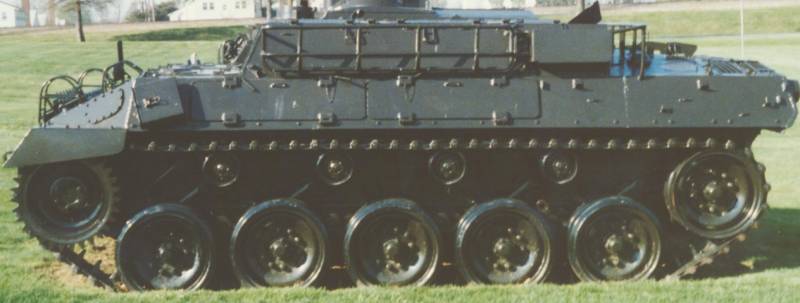
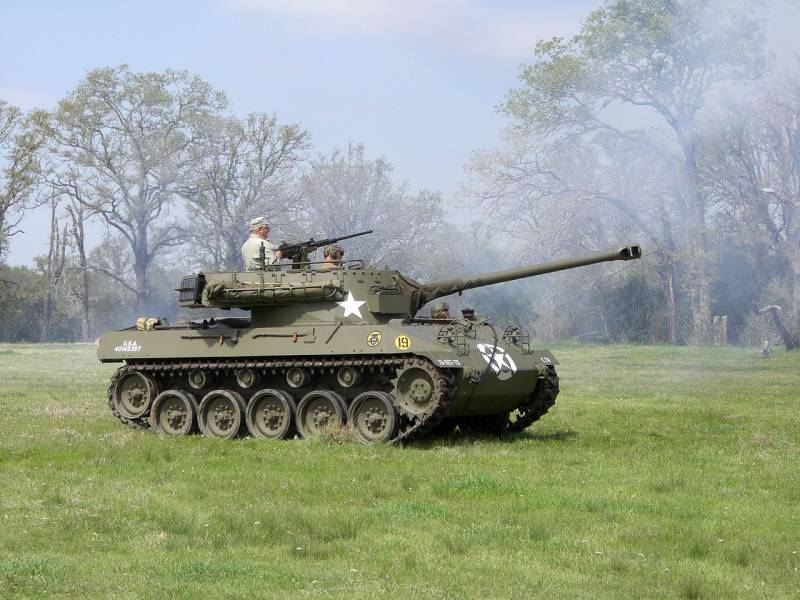
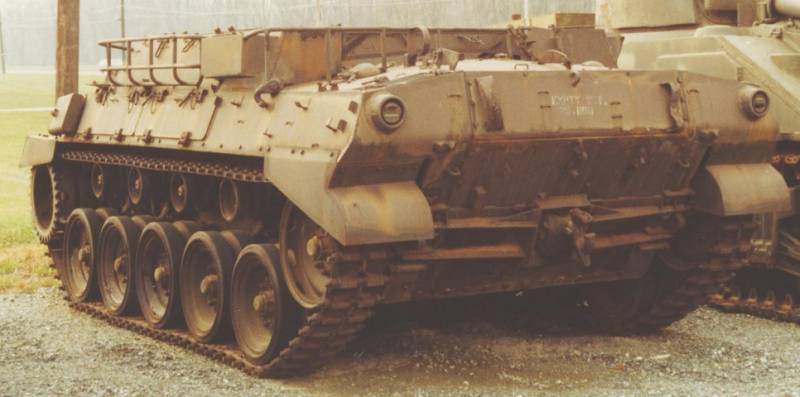
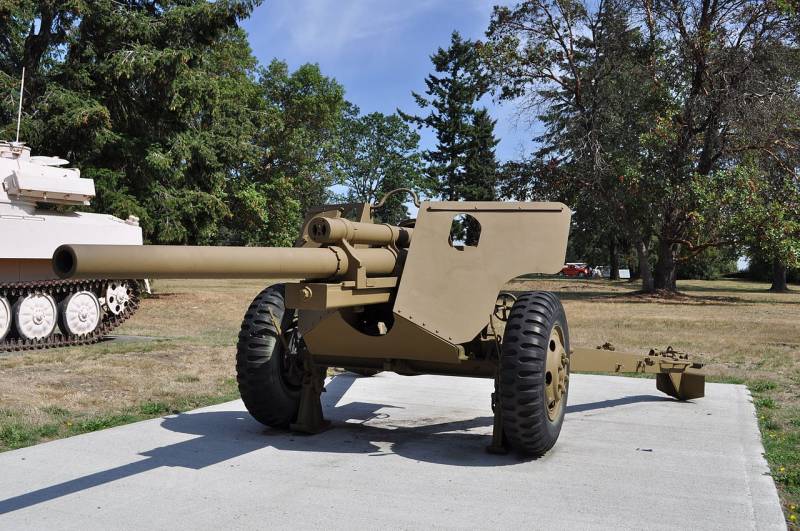

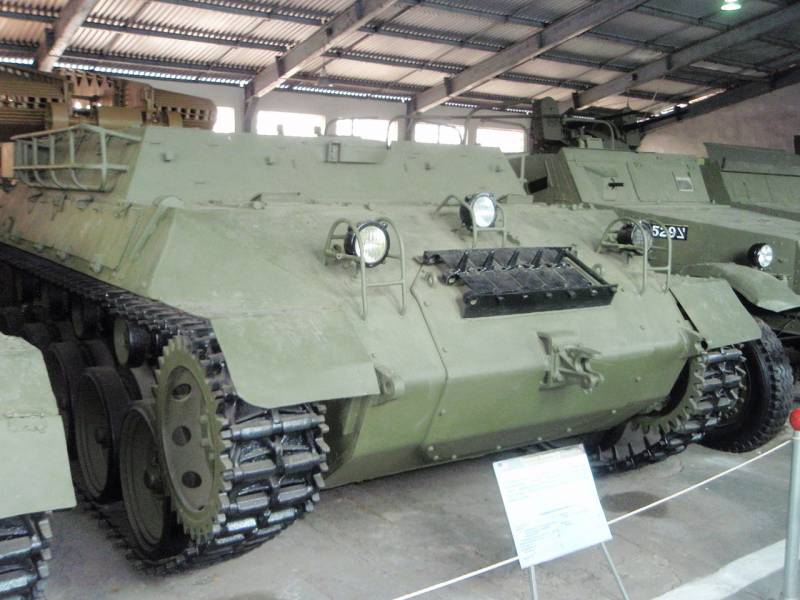
Information